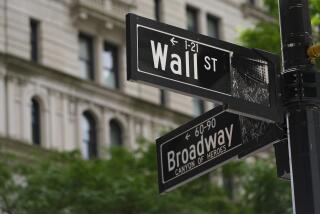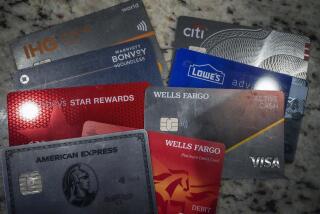Consumer Credit Has Surprise Surge in Feb.
- Share via
WASHINGTON — Consumers borrowed money at a brisk pace in February and shopped up a storm with their credit cards, despite gloomy news about the nation’s economy.
Total consumer credit increased by a seasonally adjusted $13.5 billion in February, or a 10.5% annual rate, the Federal Reserve reported Friday. That was a bigger increase than the $9.3-billion rise many analysts had forecast.
Economists were surprised by the performance, given low consumer confidence, stock market volatility, high energy prices and a weaker job market--factors that tend to make people feel less inclined to spend.
Separately, the Commerce Department said that U.S wholesalers’ stockpiles fell modestly in February, and that sales also declined. Wholesale inventories fell 0.1% to a seasonally adjusted $327.04 billion in February, after declining by a revised 0.4% in January. The back-to-back declines followed almost two years of rising inventory levels.
In January, consumer borrowing grew by $16 billion, or a breakneck 12.5% rate. That marked the fastest growth in credit since November.
February’s growth in overall borrowing by consumers was led by a big jump in credit card use.
Demand for revolving credit, such as that used for credit cards, rose by a huge $11 billion, or a 19.9% rate in February, up from $6.4 billion and an 11.6% rate in January. The growth in revolving credit in February was the biggest one-month gain since September 1995, when revolving credit rose by $11.5 billion, or an astronomical rate of 33%.
“The torrid pace of revolving debt suggested that consumer fears of recession couldn’t force spenders to keep their credit cards in their wallets,” said Richard Yamarone, economist for Argus Research Corp. “If you are the slightest bit hesitant about your financial future, you don’t accumulate credit card debt at a 19.9% annualized pace,” he said.
Nonrevolving credit, such as loans for new cars, vacations and other big-ticket items, grew by $2.4 billion, or an annual rate of 3.3% in February. That was down from $9.6 billion and a 13.2% rate the month before.
The Fed’s report on consumer credit includes credit card debt and loans for autos, boats and mobile homes. It does not include loans backed by real estate, such as home mortgages or increasingly popular home equity loans.
The Federal Reserve slashed interest rates three times this year, a move aimed at boosting economic growth and staving off recession.
More to Read
Inside the business of entertainment
The Wide Shot brings you news, analysis and insights on everything from streaming wars to production — and what it all means for the future.
You may occasionally receive promotional content from the Los Angeles Times.









